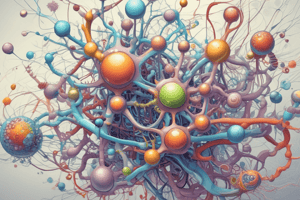Podcast
Questions and Answers
¿Qué es la señalización celular?
¿Qué es la señalización celular?
Es un proceso complejo donde las células se comunican entre sí y responden a estímulos externos.
Menciona dos tipos de señalización celular y descríbelos brevemente.
Menciona dos tipos de señalización celular y descríbelos brevemente.
La señalización paracrina, que ocurre entre células cercanas, y la señalización endocrina, que utiliza hormonas para comunicarse en todo el cuerpo.
¿Cuál es la importancia de las quinasas en la señalización celular?
¿Cuál es la importancia de las quinasas en la señalización celular?
Las quinasas activan y regulan diversas rutas de señalización al fosforilar proteínas.
¿Qué determina la función de una proteína?
¿Qué determina la función de una proteína?
Describe la estructura primaria de una proteína.
Describe la estructura primaria de una proteína.
¿Qué son las interacciones no covalentes y su rol en las proteínas?
¿Qué son las interacciones no covalentes y su rol en las proteínas?
¿Qué sucede durante la desnaturalización de una proteína?
¿Qué sucede durante la desnaturalización de una proteína?
¿Qué es la conformación con la menor energía libre en el plegamiento de proteínas?
¿Qué es la conformación con la menor energía libre en el plegamiento de proteínas?
Flashcards
¿Qué es la bioquímica?
¿Qué es la bioquímica?
El estudio de los procesos químicos dentro y relacionados con los organismos vivos, enfocándose en la estructura, función e interacciones de macromoléculas como proteínas, carbohidratos, lípidos y ácidos nucleicos.
Señalización celular
Señalización celular
Proceso complejo en el que las células se comunican entre sí y responden a estímulos externos, involucrando una cascada de eventos moleculares que transmiten información entre diferentes partes de la célula o entre células.
Tipos de señalización celular
Tipos de señalización celular
Contacto dependiente, paracrina, sináptica y endocrina; cada una con un mecanismo específico de interacción entre células.
Estructura primaria de una proteína
Estructura primaria de una proteína
Signup and view all the flashcards
Estructura terciaria de una proteína
Estructura terciaria de una proteína
Signup and view all the flashcards
Función de las proteínas
Función de las proteínas
Signup and view all the flashcards
¿Qué es la desnaturalización de una proteína?
¿Qué es la desnaturalización de una proteína?
Signup and view all the flashcards
Fuerzas que estabilizan la estructura de las proteínas
Fuerzas que estabilizan la estructura de las proteínas
Signup and view all the flashcards
Study Notes
Biochemistry
- Biochemistry is the study of chemical processes within and relating to living organisms.
- It focuses on the structure, function, and interactions of biological macromolecules such as proteins, carbohydrates, lipids, and nucleic acids.
- Key areas of biochemistry include metabolism, enzyme kinetics, and the regulation of cellular processes.
- It plays a vital role in understanding human health, disease, and the function of specific living processes.
Cell Signaling
- Cell signaling is a complex process by which cells communicate with each other and respond to external stimuli.
- It involves a cascade of molecular events that transmit information from one part of a cell to another or from one cell to another.
- The process typically involves receptors, intracellular messengers, and effector molecules.
- Cells use various signaling mechanisms, including:
- Contact-dependent signaling: Direct cell-to-cell contact
- Paracrine signaling: Signaling between nearby cells
- Synaptic signaling: Specialized signaling in the nervous system
- Endocrine signaling: Signaling using hormones throughout the body
- Signaling pathways often involve the activation of protein kinases and phosphatases.
- Signaling can lead to many cellular responses such as gene expression, metabolism, growth, and cell death.
- Signal transduction is crucial in maintaining cell homeostasis and regulating various biological processes.
Protein Structure
- Proteins are essential macromolecules performing diverse cellular roles.
- Their structure directly determines their function.
- Proteins are composed of amino acids linked by peptide bonds.
- The primary structure of a protein is the linear sequence of amino acids.
- The secondary structure is formed by local folding patterns like alpha-helices and beta-sheets.
- The tertiary structure is the overall three-dimensional shape of the polypeptide chain.
- The quaternary structure describes the arrangement of multiple polypeptide chains in a protein complex.
- Protein structure is stabilized by various non-covalent interactions, including hydrogen bonds, ionic bonds, hydrophobic interactions, and van der Waals forces.
- Protein folding is a complex process driven by the tendency of the polypeptide chain to adopt the conformation with the lowest free energy.
- Denaturation can disrupt the native structure of a protein, often leading to loss of function.
- Protein structure can be analyzed using techniques like X-ray crystallography, NMR spectroscopy, and computational modeling.
- Protein structure prediction is a crucial area of research, leading to advancements in drug discovery and biotechnology.
Studying That Suits You
Use AI to generate personalized quizzes and flashcards to suit your learning preferences.




